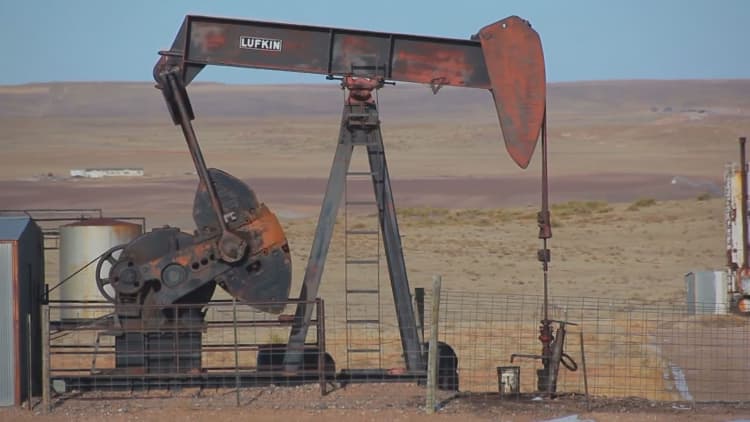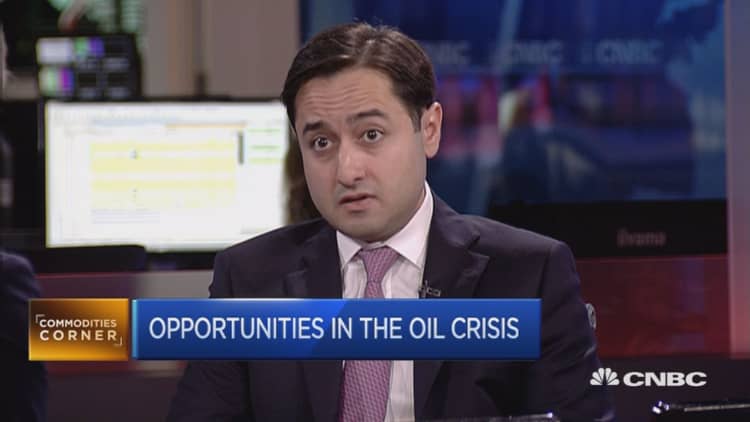


Oil prices stabilized on Thursday, though futures remained under pressure on signs of another storage build at the hub for U.S. crude futures.
In early trade, U.S. crude's West Texas Intermediate (WTI) futures surged to a 2016 peak as the International Energy Agency raised its 2016 global oil demand growth forecast to 1.2 million barrels per day (bpd) from 1.16 million in April.
Brent crude futures also rallied early as the IEA, the western world's energy watchdog, noted output from Nigeria, Libya and Venezuela is down 450,000 bpd from a year ago.
U.S. West Texas Intermediate (WTI) settled 1 percent higher, or 47 cents, at $46.70 on Thursday, having earlier hit $47.02, the highest level since early November.
International Brent crude futures were trading at $47.99, up 0.8 percent. They were off an intraday high of $48.12.
Both crude benchmarks slid after market intelligence firm Genscape reported a 548,923-barrels build at the Cushing, Oklahoma delivery point for WTI futures during the week to May 10.
The Genscape data covered the week when some 1 million bpd in Canadian crude supply were offline from wildfires in Alberta's oil sands region. The data worried traders since that crude typically flows to Cushing.
"I don't know how to play this," said one market participant who provided the Genscape data to Reuters.
"I'm in a bearish frame of mind, yet someone made a pretty good argument that this week's stats will show the Canadian shutdown effect," he added.
The U.S. Energy Information Administration (EIA) said on Wednesday that U.S. crude inventories fell 3.4 million barrels to 540 million barrels last week, compared with analyst expectations for an increase of 714,000 barrels and the American Petroleum Institute's (API) reported build of 3.5 million barrels in preliminary data issued on Tuesday.
"With (refinery) runs recovering and production dropping, U.S. (crude) stocks should begin drawing steadily from now," consultancy Energy Aspects said on Thursday.
"We estimate that North American inventories can fall by as much as 12 million barrels across May and June," it added.
Traders said an expected increase in Canadian oil sands output following disruptions to over 1 million bpd production capacity due to a wildfire was weighing on markets.
Workers for Suncor Energy, one of the largest oil sands companies affected by the wildfire, will also begin returning to the shuttered facilities on Thursday, a union official said, in an indication of returning supply.
"We had a couple of good days of upside here," Robert Yawger, director in energy at Mizuho Securities USA, said, referring to this week's rally. "I would tend to believe as you get the headlines that are announcing flows coming back from Alberta, it would tend to put some pressure on the market here."
Kuwait's acting oil minister said that recent price rises were fundamentally justified.
"Based on the decrease in production that has been shown in the last three weeks, I assume fundamentally the price represents the fall of production," Kuwait's acting oil minister Anas al-Saleh told Reuters on Thursday.
He also said that the Organization of the Petroleum Exporting Countries (OPEC), of which Kuwait is a member, would not seek price supporting market intervention during its next scheduled meeting on June 2, and instead focus on dialogue among the producer cartel.
At an April producer meeting, OPEC rivals Saudi Arabia and Iran could not agree on deal terms, triggering criticism that the producers' cartel had lost its ability to act.





